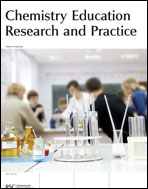Modes of reasoning in self-initiated study groups in chemistry
Abstract
Characterizing the modes of reasoning typically applied by students to solve different types of chemistry problems is of central importance for the design of instructional strategies that can better support their learning of specific content. Thus, the central goal of this study was to identify dominant modes of reasoning expressed by college chemistry students while working in self-initiated study groups. We were particularly interested in exploring potential relationships between modes of reasoning, content focus of group discussions, and levels of cognitive processing. Our study was based on the analysis of student conversations in 34 study sessions of 14 study groups involving over 100 students enrolled in the first semester of college organic chemistry. Our analysis indicated that most of the content-related conversations in the study could be categorized as involving at least one of four major reasoning modes: Model-based reasoning, case-based reasoning, rule-based reasoning, and symbol-based reasoning. In general, group talk was largely focused on issues of representation and structure which preferentially invoked rule-based reasoning; discussions about chemical reactions heavily relied on case-based reasoning. Overall, model-based reasoning was minimally applied. In general, over 70% of the content-related conversations corresponded to lower levels of cognitive processing. Rule-based thinking and case-based thinking were often based on students remembering and applying knowledge. Although model-based reasoning was used scarcely, it more frequently led to higher levels of cognitive processing. The results of our work provide insights into how to modify instruction to better support students' reasoning inside and outside the classroom.

 Please wait while we load your content...
Please wait while we load your content...